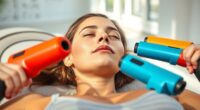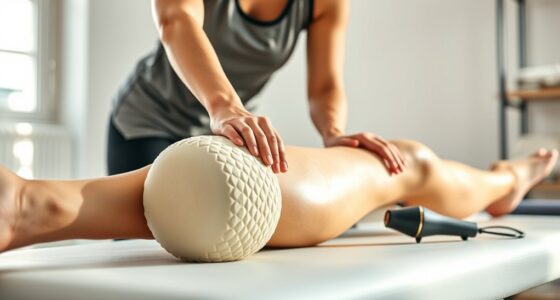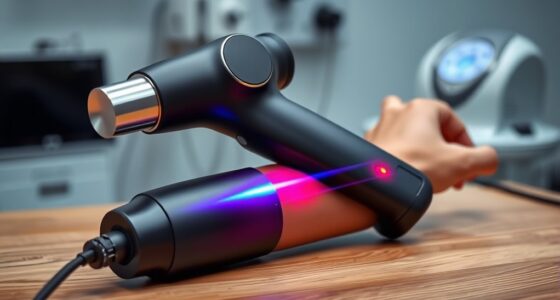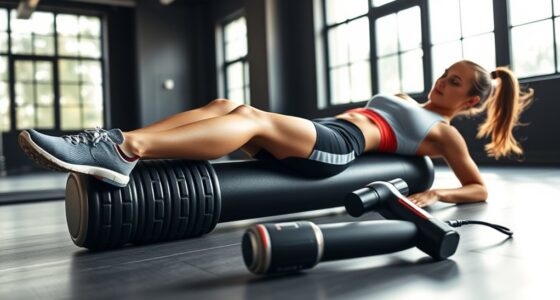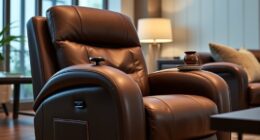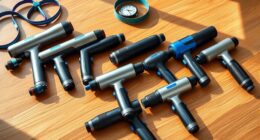To optimize your post-workout recovery, use a combination of massage guns and ice baths. Massage guns help boost blood flow, loosen tight muscles, and break down adhesions, speeding up healing. Ice baths reduce inflammation, swells, and muscle soreness effectively. When you combine both, you target different recovery aspects—enhancing healing and preventing injuries. Keep exploring for tips on how to integrate these methods seamlessly into your routine and maximize results.
Key Takeaways
- Combining massage guns and ice baths targets multiple recovery aspects: circulation enhancement and inflammation reduction.
- Use massage guns immediately after exercise to stimulate blood flow and loosen muscles before cold immersion.
- Incorporate ice baths post-massage to reduce swelling, manage soreness, and promote rapid recovery.
- Alternating between massage therapy and cold exposure optimizes tissue repair and minimizes muscle tightness.
- Tailoring the timing and sequence of both methods enhances overall recovery efficiency and training consistency.
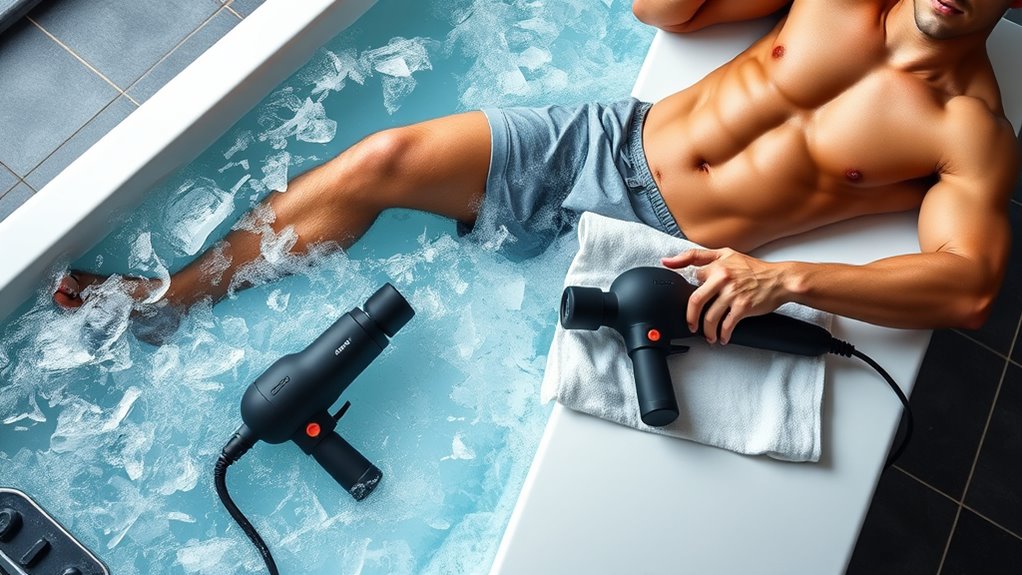
After a tough workout, your body needs proper recovery to repair muscles, replenish energy, and prevent injury. One of the most noticeable signs that your body is in need of recovery is muscle soreness, which often peaks 24 to 48 hours after exercise. This soreness occurs because microscopic tears develop in your muscle fibers during intense activity. To ease this discomfort and promote healing, improving blood circulation is essential. When blood flow increases, oxygen and nutrients reach your muscles more efficiently, helping clear out metabolic waste products that contribute to soreness. Techniques like massage guns can be highly effective in this process. By applying targeted percussive therapy, a massage gun stimulates muscle tissues, reducing tightness and accelerating blood flow. This increased circulation not only alleviates muscle soreness but also speeds up recovery, allowing you to get back to your routines quicker.
Effective recovery after workouts boosts blood flow, reduces soreness, and speeds up muscle repair.
Using a massage gun regularly after training helps break down adhesions in your muscles, which can form from repeated strain or tightness. By loosening these adhesions, you restore normal muscle function and improve flexibility. The percussive action penetrates deep into muscle tissue, promoting better blood circulation and helping to flush out lactic acid and other byproducts that cause soreness and fatigue. This makes massage guns a practical, non-invasive tool for recovery, especially after intense workouts or long training sessions. Additionally, integrating high refresh rates in recovery devices can enhance the effectiveness of blood flow stimulation by providing smoother and more consistent percussive movements.
Aside from massage guns, ice baths are another recovery strategy that targets muscle soreness. Immersing yourself in cold water causes blood vessels to constrict, reducing inflammation and swelling. Once you step out of the bath, the rapid rewarming of tissues prompts a surge of blood flow, delivering fresh oxygen and nutrients to your muscles. This cycle of constriction and dilation helps clear out metabolic waste and decreases soreness. While ice baths can be uncomfortable, many athletes swear by their effectiveness in minimizing post-exercise inflammation and speeding up recovery time.
Incorporating both massage guns and ice baths into your post-workout routine can give you a distinct advantage. Massage guns help stimulate blood circulation actively, loosening tight muscles and reducing soreness, while ice baths manage inflammation and swelling. Using these tools strategically allows you to target different aspects of recovery, ensuring your muscles get the attention they need to heal properly. Whether you’re a seasoned athlete or someone who trains casually, understanding how to optimize blood flow and reduce muscle soreness is key to staying consistent, avoiding injury, and feeling your best after every workout.
Frequently Asked Questions
How Often Should I Use a Massage Gun After Workouts?
You should use a massage gun after workouts when you notice tight muscles or trigger points that need relief. Typically, 1-2 times a day is enough, focusing on areas like your quads, hamstrings, or calves. It’s helpful to combine the massage gun with foam rolling for deeper muscle relaxation. Just avoid overdoing it to prevent soreness, and listen to your body for the best recovery results.
Are Ice Baths Suitable for Everyone?
Think of ice baths as a chill breeze for your muscles, offering cold therapy that can promote muscle relaxation. However, they’re not suitable for everyone—people with circulatory issues, cardiovascular conditions, or skin sensitivities should avoid them. Cold therapy can be invigorating for some, but risky for others. Always listen to your body and consult a healthcare professional before diving into ice baths to guarantee they’re safe for you.
Can Recovery Methods Replace Proper Nutrition?
Recovery methods can’t replace proper nutrition, but they complement it. Your nutrition priorities, like balanced carbs, proteins, and fats, provide essential fuel and repair nutrients. While supplementation benefits can support your goals, they don’t substitute the crucial role of real food. Focus on maintaining a healthy diet first, then use recovery techniques like massage guns and ice baths to enhance muscle repair and reduce soreness effectively.
What Are the Signs of Overusing Recovery Techniques?
Like Icarus flying too close to the sun, overusing recovery techniques can lead to setbacks. You might notice persistent soreness, increased fatigue, or mood swings, signaling you’re overdoing it. Ignoring hydration needs and neglecting mental relaxation may worsen symptoms. Keep balance in mind—use recovery tools wisely, listen to your body, and avoid the trap of dependence, ensuring your recovery supports your overall health and performance.
How Long Should I Spend in an Ice Bath?
For cold exposure during an ice bath, aim for 10-15 minutes. Spending too long can cause skin damage or hypothermia, while too short may not provide enough muscle relaxation benefits. You should listen to your body and exit if you feel numb or uncomfortable. Generally, 10-15 minutes balances effective muscle relaxation with safety, helping your muscles recover without risking adverse effects.
Conclusion
Incorporating massage guns and ice baths into your recovery routine can considerably reduce soreness and boost performance. Imagine you’re a runner feeling tight after a long race; using a massage gun on your calves and taking an ice bath could help you recover faster and get back to training sooner. Consistency is key, so experiment with these methods to find what works best for you. With the right approach, you’ll feel stronger and more prepared for your next workout.

